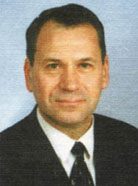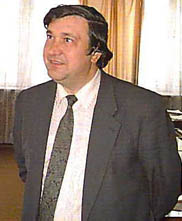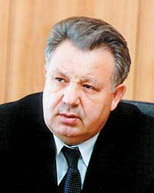 Victor
Fersht,
Victor
Fersht,
Doctor of Philosophy with specialization in the field of Psychology,
Professor of the Far Eastern State Academy of Economy and Management.
Born January 22, 1948 in Nikolaevsk-on-Amur, Far Eastern Region of Russia.
Graduated from Oriental Institute of the Far Eastern State University in
Vladivostok.
Studied on post-graduate courses at the Russian Academy of Sciences Institute
of Far East in Moscow.
Received PhD. at the Berne University in the USA.
Worked at the Presidium of the Far Eastern Center of the Russian Academy
of Sciences then at the Government of Russia and at the Parliament
(Duma)
of the Russian Federation.
Acted as a Director of the Institute of psychological prevention of the
terrorism of the All-Russia Center for the catastrophe medicine Defense
attached to Ministry of Health of the Russian Federation.
Now he is a Director of Russian organization Physicians for Human Rights
and General director of the United Nations Habitat Center for Asia Pacific
countries Best practices and local leadership.
WHAT FUTURE awaits the Far East of Russia? Will it be a prosperous Russian region, or will it become a territory of China, Japan or America?
There are a lot of opinions on this problem. But still now nobody has dared to recognize firmly that the Russian Far East has practically no prospects.
Many of the economists and politics are hinting at such a result just basing on their empirical views.
Well known Russian scientists Victor and Oleg Bulgakov and Victor Belkin, authors of the recently published book SMacro economy and main capital of Russian regional economic systems repro-ductionl/l, were the first who have openly said about it by means of computer modeling language.
Some words about the authors first.
 Victor
Belkin is a President of the Far Eastern State Academy of Economy
and Management, professor, Doctor of economic sciences. He has a great
experience in economic research; many of his ideas were implemented in practice.
His Academy is the only highest educational institution in the region, which
prepares specialists in finance and management. Governors and bank directors,
chairmen of arbitrage courts and oligarchs teach the students at this Academy.
Its graduates occupy almost all the main commanding posts in the economy
and up-level management of the Russian Far East.
Victor
Belkin is a President of the Far Eastern State Academy of Economy
and Management, professor, Doctor of economic sciences. He has a great
experience in economic research; many of his ideas were implemented in practice.
His Academy is the only highest educational institution in the region, which
prepares specialists in finance and management. Governors and bank directors,
chairmen of arbitrage courts and oligarchs teach the students at this Academy.
Its graduates occupy almost all the main commanding posts in the economy
and up-level management of the Russian Far East.

Victor Bulgakov is a Professor of computer programs department of Khabarovsk State Technical University, a chief scientist of the Computer center of the Far Eastern Branch of Russian Academy of Sciences. He is one of the world known scientists working in the field of math modeling of rocket fuel theory.
 Oleg
Bulgakov represents a young generation of math economists,
using methods of mathematical modeling in economy. His views are especially
interesting for understanding the future prospects of the Far East, because
it is his generation, who will live and work here during nearest future.
Oleg
Bulgakov represents a young generation of math economists,
using methods of mathematical modeling in economy. His views are especially
interesting for understanding the future prospects of the Far East, because
it is his generation, who will live and work here during nearest future.
The book can attract exclusive attention of the readers, who try to understand
and analyze the situation in modern Russian Far East economy basing on precise
methods of scientific research. A new classification of production process
functions (V- functions) is suggested in the book for the first time. These
functions allow provide theoretical description of the economical process
in Russia in this transition period, while common statistic data are essentially
limited and suffer from substantial errors.
The theme this booklet is devoted to is Best Practices & Local Leadership.
Applying to this theme the conclusion made by the authors is the main merit of
Viktor Belkins book. It is for the first time in modern history that mathematical
computer modeling showed economic collapse of Russia in the Russian Far East.
Practical governing activity of Russia and its Far Eastern regions during modern
transition period proved to be faulty, leading to cruel economic crisis and exhaustion
of human resources.
Computers, used by the authors for modeling the future situation gave two different
sceneries of events developing. If the federal center changes its policy and
begins intensive settling of the territories, that are almost uninhabited now,
if financial support of the region is increased in hundred and hundred times,
if foreign companies are given substantial privileges for investments, the scenery
of the Russian Far East development is favorable. It will remain as a part of
Russia. If everything goes on the same way as now, the Russian Far East will
be lost for Russia.
Empty space must always be filled by something. If we have vacuum in one place
and surplus of material in another nearby, it goes without saying that this vacuum
will be filled up with some substance. Deserted Russian Far Eastern lands are
surrounded by territories of China, Japan and the United States, overfilled by
people and money. Their expansion to empty and deserted neighboring lands is
inevitable sooner or later.
What do well known Russian scientists and politics think about it?
 Nikolay Dobretsov, academician, a head of Siberian Branch
of Russian Academy of Sciences:
Nikolay Dobretsov, academician, a head of Siberian Branch
of Russian Academy of Sciences:
The Far East is separated from Russia even today. Only 10% of its production
is used in Russia. The same situation is in the Eastern Siberia. If raw material
orientation in policy continues to prevail, the connection with the center
will be even more loosening. Raw materials will be exported into China, Japan
and Korea. The capitals will be removed there too. In all economic relations
Russian Siberia and the Far East will be gradually torn off the Russian center.
I do not want to frighten us by gloomy perspectives but we must clearly realize:
this variant is inevitable without serious state regulating program.
There exist very dangerous illusions that high technologies should be developed
in the European part of Russia, and Siberia and Far East are to be used only
as a source of raw material for this purpose. Such policy will lead to one
result. The whole Russia will become a raw material appendix of highly developed
countries.
If only raw materials are used, if Chinese human resources continue their
expansion to Siberia and Russian Far East these territories will be practically
cut off from Russia.
 Victor
Ishaev, Governor of Khabarovsk Region:
Victor
Ishaev, Governor of Khabarovsk Region:
Economics of the Russian Far East appeared to be cut off the internal market
of Russia and CIS states. We turned out to be pushed off the integral whole
of Russian economic area.
Weve lost 11% of population. All the losses are connected with migration.
Moreover, people who had gone and are going now are the most qualified, mobile
specialists. During last 9 years the population of the region has reduced
for 897 thousand of people.
A group of leading scientists from Economical Department of the Russian Academy
of Sciences, with me taking my modest part in their work, has worked out
a conception of strategic development of Russia up to year 2010. This conception
was presented to State Duma and State Council of the Russian Federation.
It is apparently clear from this work that in the Russian Far East as well
as in all eastern and northern regions of Russia in general, market relations
in themselves are not able to ensure subtle adjustment of mutually interacting
markets. Such adjustment should be supported and corrected by state policy.
From the very beginning of radical economic reforms the policy of state patronage
was lost in the past. But general illusions that market itself can automatically
provide conditions for efficient development in all areas turned out to be
a great loss to the whole country and to the Far East especially.
All of us can guess that situation in the Russian Far Eastern region is critical.
It was clearly and definitely demonstrated by winter of 2001. But why does
the federal state look at the things happening in one of the richest parts
of Russia so indifferently?
Pavel Minakir, correspondent member of Russian Academy of Sciences, Director of the Economic Research Institute, Far Eastern Branch of Russian Academy of Sciences:
The Russian Far East has appeared to be doomed to gradual curtailment of economic activity. All attempts to conquer this tendency come up against lack of clear perspective, lack of precise notion of real economic potential of the regions development and the ways of its realization.
 Peter
Baklanov, academician, Director of the Pacific Institute of Geography,
Far Eastern Branch of Russian Academy of Sciences:
Peter
Baklanov, academician, Director of the Pacific Institute of Geography,
Far Eastern Branch of Russian Academy of Sciences:
Weve tried to evaluate amount of favorable and unfavorable influences of
geopolitical factors to long term development of the Russian Far East. The
favorable influences are: the regions nearness with the largest, highly developed
or developing countries of Asia-Pacific Community over the many kilometers
of sea and land boundaries; these countries steady interest in the region,
its natural resources, potential and geographic position; ability to carry
out contact functions in inter-regional and inter-state relations; and some
others.
As for unfavorable influences, they are: great differences in political systems
of Russia and its neighbors; negative transbordering gradients; and a number
of complicated unsettled geopolitical problems. Increasing geopolitical interest
of some countries to rich with resources lands and sea areas, such as gas
and fuel fields in Yakutia, Okhotsk Sea and Arctic shelf, fishery zones of
Okhotsk and Bering Seas, international waters of the Pacific Ocean, can also
be regarded as unfavorable influences.
In future strengthening of confrontation in crossing of geopolitical interests
of different countries, the large ones especially, can lead to new conflict
situations and even to new geopolitical problems.
Thus summing up the positive and negative factors we cannot evaluate the present
geopolitical situation in the Russian Far East as good or favorable. In fact
it is rather not very favorable and can be worse in perspective.
 Mihail
Titarenko, correspondent member of Russian Academy of Sciences,
Director of Oriental Studies Institute of the Russian Academy of Sciences:
Mihail
Titarenko, correspondent member of Russian Academy of Sciences,
Director of Oriental Studies Institute of the Russian Academy of Sciences:
Development of Siberia and the Russian Far East - it is a question of our
future. Will there be Russia or not? Will it be Russia or Moscovia?
Purely marketable attitude towards Siberia and Far East does not provide possibilities
for these regions development. Moreover, such attitude turns these regions
into stock of goods. As for goods, they are to be sold in order to get maximum
profits. Therefore there are some hot-heads already, who have suggested the
idea of selling the Russian Far East to the United States of America. There
was a precedent with Alaska, wasnt it?
 Alexander Granberg, academician.
Alexander Granberg, academician.
In 1996 President of Russia signed a program of social and economic development
of the Russian Far Eastern regions and the regions to the east of Baykal.
This program was worked out under academician Granbergs guidance. Our prominent
specialists opinion has been becoming called for in the Government of President
Putin. This is a good sign. It can show that the country leader has turned
his face towards genuine science.
The state has struck three hard blows upon the Russian Far East. What can
happen if the main investor - the State - leaves the region? How should the
economic react to tariffs bar between Far Eastern regions and the other parts
of Russia?
The volume of eastern regions financing in the federal programs comes to
only 9% of scientifically based amount. Is it possible to build a plane or
nuclear reactor if they pay less than one tenth of the money?
Ill remind several facts for better understanding. Every year from 20 to
25 billion of dollars go out from Russia. Annual federal investments into
Far Eastern economy come to average amount of 100 million dollars. By the
way, Far Eastern regions include 40% of all Russian territory. So we can
see that the investments from the state are just miserable. But it is not
only the matter of finance. The essence of the program was in creating adequate
organization and economic mechanisms. And precisely in this direction nothing
had been done at all. Time goes on but we can see no changes in this position.
There exist several sceneries of events developing in the Far East. It is
clear enough that no one of them can be realized as it is planned.
 Yury
Osipov, academician, President of the Russian Academy of Sciences:
Yury
Osipov, academician, President of the Russian Academy of Sciences:
These problems should be discussed not from the point of view of the Russian
Far East problems. We must discuss them from the point of view of Russias
interests in the Far East. This is a principal note.
Arkady Alexeev, ex-vice-president of the Far Eastern Branch, Russian Academy of Sciences:
I cannot say for sure either I am an optimist or a pessimist.
We must speak about the country as a whole, without separating of Far Eastern
economy into something special. We must not divide problems in the field
of science and all other sides of the states life. Otherwise well come
to one result the Russian Far East will become just a reservoir of natural
raw materials. And its difficult to say who will take from this reservoir
China or Japan.
 Victor
Larin, director of the Institute of History, Archeology and Ethnography
of the Peoples of the Far East, Far Eastern Branch, Russian Academy of Sciences:
Victor
Larin, director of the Institute of History, Archeology and Ethnography
of the Peoples of the Far East, Far Eastern Branch, Russian Academy of Sciences:
In the latest Russian-Chinese agreements Siberia is fixed to play a role
of energetic base for further modernization of China. The Far Eastern regions
future is even more vague. From the point of view of economic relations with
China, Russian Far Eastern regions work mainly for themselves. Only Amursky
Region partially fulfills transit functions. Volumes of trading operations
are minimal, Chinese investments into the region are ridiculously small.
From 1997 to 1998 Chinese enterprisers invested into economy of Primorye
about 63 thousand dollars and 3 million rubles. It is less than 1% of the
whole volume of foreign investments into our region during these years. Future
of Russian Chinese regional relations is indefinite because the very fact
of future existence of the region as a part of Russia is disputable.
As a part of common Russian economic system the region is moving far and
far from metropolis. It is difficult to understand today how Moscow sees
its function, role and goals. Is it to go on ensuring the centers interests,
to be financed and developed as a raw materials base not only for the European
part of Russia, but for the Eastern Asia foreign countries as well?
There is serious divergence of opinion in understanding of such perspectives
not only between the Center and the regions, but also among the regions themselves.
The Far East remains and will remain an outlying district, not native land
for Moscow. It will be settled in the last turn.
The Far East itself and its territories, adjacent to China, are not united,
neither in administrative, nor in political and economic sense. Interests
and possibilities of each territory in their connections with China are also
different.
Impartially speaking, only two things in Far Eastern economy today can be
called competitive it is natural raw materials and intellectual potential
of people. It is impossible to accelerate the regions development using
the existing technological basement. And it is useless to count on the Centers
active support.
Northern strategy of China today is quite evident. It pursues to aim of
using the Russian Far Eastern resources for developing of Chinese northern
and eastern territories. Analyzing experience of the 90th years we can definitely
say, that inter-regional cooperation of two countries gave maximum profits
for China, while Russian frontier territories got mainly disappointing results.
Why? The reasons are simple. The Chinese worked hard and put all earned money
in one money-box. The Russians were mainly waiting, that prosperity would
come in itself like a miracle, pulled the profits apart to their separate
corners, and even managed to scold their stubborn neighbors by the way.
There is no such strategy. All federal, regional and local programs of the
last ten years are a mere fiction. They exist only on paper, and nobody in
the region perceives them seriously.
The problem is nobody wants to analyze mistakes and learn the lessons of
experience. Scientists conclusions are not taken into account. The main
question now is what can be done in order to get maximum profit out of
mutual longing of two states for cooperation and rapprochement? But this
task concerning the Far East of Russia is not even being considered yet.
When will it be solved? Meanwhile, if Russia wants to preserve this rich
region as a part of the country, it is urgently necessary to act today. Tomorrow
it can be late.
Igor Mazharov, an independent orientalist:
Practically total disorganization of state branches of industry, and the
military ones especially, in Far Eastern regions of Russia makes us to think
in a different way of possible perspectives of the region in not very far
future.
All the conditions for it are created. The economy is ruined, there are few
Russians and many Chinese, we are passive and they are active, we extract
and they produce. Do you feel that the words turning of Russian Far East
into Chinese raw material appendix does not even cause a sense of internal
protest?
Powerful in the past, defense industry of the region has no guaranteed state
orders. Centralized investment programs, supported by real investment means
or, at least by real investment policy, are also absent. It has resulted
in mass unemployment in cities and progressive poverty in villages, departure
of population from northern areas, migration of the richest people to European
part of Russia.
Although they are spontaneous by nature, the Chinese have two undisputable
advantages over all the other nations. They can remarkably adapt themselves
to existing conditions of life, and besides, there very many Chinese in the
world. These two factors allow the Chinese during last thousands of years
to expand their area of living. This expansion is uneven and spasmodic,
but steady. They have widened the territory from a small area, limited in
ancient times by Great Wall on the North and by Nankin on the South, to
modern boundaries, and
even farther.
When visiting Omsk I made sure myself that the Chinese have become perfectly
acclimatized to conditions of Siberian severe winter. Perhaps Siberian frosts
represent much less evil for them than prohibition for giving birth to a
second child. In Vladivostok we can see the Chinese quarters again. Nursery
schools for Chinese children are being opened in Ussuriysk.
Nobody dares to say how many of Chinese are really constantly living in the
Russian Far East and Siberian regions. Someone speaks about thousands, someone
about dozens of thousands. Border troops representatives say there are hundreds
of thousands Chinese here.
Modern Russian reality makes it impossible to count on some miraculous renaissance
of powerful Russia under ruling of strong centralized Power. First of all
we need a developed economy. But Russian Far Eastern regions will not have
such economy for at least 5 or 7 nearest years. In such conditions complicated
processes connected with struggle for establishing zones of influence by
different states will take place in the region inevitably. Without any doubts,
China will take a very active and direct part in this process due to its
geographical nearness.
In the nearest future the Russian Far East and Russia as a state will have
to take Chinas opinion into special consideration and treat China as a State
pretending to play a leading role not only in the region, but perhaps in
the world.
The people in Siberia and the Russian Far East have already felt a direct and serious threat connected with Moscows influence becoming weaker, while the influence of China and pro-Chinese elements in the regions gets stronger.
Basing on their experience prominent Russian scientists are confirming results of computer economic models and mathematical forecasts concerning the future of Far East.
Danger of situation is redoubled by process of depopulation, which has begun
in Russia, and in its Far Eastern region especially. In fact the population
of the country is gradually dieing out. Our scientists had stated this fact
at the First International Forum Quality of life cooperation of science,
powers, business and society.
According to specialists investigation the rate of depopulation achieves
1% in a year. At such a speed the population will lessen in two times in
the nearest 50 years.
Investigation materials prove that the state of health of the population
began to get worse from beginning of the 90th years. Number of deaths increased
in 1.5 times as compared with the middle of the 80th years. It means that
by the beginning of 2003 about 7.7 million of people died of heart and blood
vessels deceases. Simultaneously the birth rate had doubly fallen down and
Russia lost more than 14 million of children who could have been born.
 In
order to understand the situation in the Russian Far East better, we used
the methods of computer forecasts, developed by director of mathematical sociology
laboratory of Central Economy Mathematical Institute of Russian Academy of
Sciences professor Yury Gavrilets. Results of computer forecast gave us the
following picture:
In
order to understand the situation in the Russian Far East better, we used
the methods of computer forecasts, developed by director of mathematical sociology
laboratory of Central Economy Mathematical Institute of Russian Academy of
Sciences professor Yury Gavrilets. Results of computer forecast gave us the
following picture:
A map of the Russian Far East in 2050
Computer simulation. Pessimistic prediction. See Victor Belkin and others
book.

I want to underline that computer modeling is a matter of probability. The
forecast will probably be precisely realized in 50% of cases. However, if
we compare results of computer modeling and sceneries of development, described
in Victor Belkins book, therell be left no doubts that the Russian Far
East will be separated from Russia.
Neither China nor Japan ever concealed their desire to get the nearby territories.
This fact is quite understandable for wise scientists, who take into account
that these lands had already been under the above countries guidance in the
past. That is why China and Japan never invested large money into the Russian
Far East economy. Why should they give money to the Russians, if the territories
will return to them soon?
 Victor Ishaev, Governor of Khabarovsky Region:
Victor Ishaev, Governor of Khabarovsky Region:
Japan is the strongest investor not only in the Asia-Pacific region, but
in the world. During last 26 years Japan has invested 620 billion of dollars
into economy of different states. And who has got these credits? The most
poor, developing countries, such as the USA 24%! China has got 7%, and
Russia 0,054%, Far Eastern part of Russia 0,025%. Theres a great potential
for economic cooperation, but theres no political will for it.
Last years produced an exclusive opportunity to change the situation with
Japanese investments, and with Far East development as a result. The Japanese
are ready to invest billions of dollars into projected oil pipeline Siberia
Primorye. Moreover, they are ready to finance not only its construction.
The questions of financing new social and ecological programs, creating new
working places and even new enterprises are being discussed. At last Primorsky
and Khabarovsky regions have got a chance to violate pessimistic forecasts
of the scientists.
Construction of pipeline through Primorye to Japan corresponds with the Federal
Program of Far East development.
Wed like to know who is interested in blocking up the mechanism of realization
of the federal program that stipulates every step of Far East development
in details?
At a meeting in Blagoveschensk president Putin stressed the fact that corrupted
state officials in Moscow and in regions were the last persons who were interested
in realization of this program. Time passed since July of 2000, but the situation
has not changed, although the president not only agreed with the scientists,
but also angrily blamed corruption.
Americas position is more complicated. The USA never ruled Russian territories.
But experience of getting and settling of Alaska showed that such variant
is profitable for the Americans. The Americans have never and nowhere declared
their demands for Russian territories. There was only one precedent with
Russian territorial waters in the Pacific Ocean in our modern history. But
it was the Government of the USSR who had presented those spaces to America.
However the Americans do not object to consider such variants even if it
is a purely theoretical matter. They are good politics and declare they do
not expect Russia separation.
But diplomats never say aloud what they think. The mere fact of statements
concerning possible territorial questions in the Far East indicates that
this question worries the Americans as well.
 Zbigniew
Brzezinski:
Zbigniew
Brzezinski:
I can guarantee if we allow free visa regime with Russia, many Russian
people will want to leave for America. Those, who live in poor and deserted
Russian villages, those who live in Vladivostok without water and electricity,
surely they would like to go to America for living.
There exist two Potyemkin Villages in Russia they are Moscow and Saint
Petersburg. Everything around these cities was falling into decay during
last ten years after the Soviet Union had been crashed. To the east of Ural
the country is being rapidly depopulating. People go to the center of Russia.
A third part of the population lives in the cities built in Soviet times
without any economic reasons. They are a hard burden to economic of the country
now. Russias leaders must understand that in future the human factor but
not vast territories is to determine the policy.
David Wolf, Senior Scientist of Woodrow Wilson Center:
Russian territories on the Pacific coast are being removed from the other
regions of the country. There are almost no chances for Russia to play a
dominating role in Asia Pacific community. Russia should limit its aims.
Asia Pacific Community is rather a new conception.
It was suggested by the USA in the 80th years to demonstrate that the United
States could be included in that region. It is surprising to hear that Russian
scientists do not even mention the USA in their reports devoted to Asia - Pacific
issues. Surely America will regard it as an attempt not to allow us into the
region. But it is very difficult to organize anything in the world market without
the USA consent.
Sherman Garnet, Moscow Carnegie Center:
The USA policy in Asia must take into consideration such factor as Russias
weakness, which can become a reason of tension and instability on the continent.
The Far East will remain one of the most politically vulnerable and economically
weak regions of Russia during the nearest years. But this weakness will not
lead to separation from Moscow. It is more probable that the region will
remain an area of demographic, political and economic processes that will
disturb Russia and other Asian countries.
Even if it is possible to avoid chaos in the Russian Far East, the future
of the North-East Asia is rather complicated. The United States will gain
nothing if territorial status-quo in the region is in danger or if the situation
remains instable here for many years.
Potential danger of Russias weakness in the Far East and in Asia in general
must become a subject of diplomatic negotiations between the USA from one
side and Russia, China and especially Japan from another one. Assistance
in large scaled economic reforms in this part of Russia and its integration
into the processes of dynamic economic rise within the limits of Asia Pacific
region must be an important element of these negotiations. Japan and Korea
will play a key role in achieving success in this matter.

Dmitry Trenin, Deputy Director of Moscow Carnegie Center:
If Russia is not able to become an Asia-Pacific country as well, the future of its Siberian and Far Eastern territories seems to be sad. Russias exodus from Asia could also mean the end of Russia, at least the Russia as it was known to the world during last 300 years. It will also mean beginning of great upheavals on the continent.
First Pacific¹, an independent organization for public opinion study,
conducted a public opinion poll of people living in the Far East, asking
them two questions. In what country will ou or your descendants live in
25 years? How do you feel about it? 52% of the inquired, mainly the inhabitants
of Primorsky and Khabarovsky regions, said they would live in China. 12%
(from Chukotka and Kamchatka mainly) said they would live in the USA. 10%
of the respondents, who mainly live in Sakhalin and Kuril Islands, believe
they would live in Japan.
Only 26% of the people hope that the Russian Government will be able to hold
control under eastern territories. 53% of the inquired approve of such geopolitical
changes.
Results of public opinion roll and opinions of Russian and foreign specialists
stated above confirm that the computer model of the region future, described
in Belkin and the Bulgakovs book is true.
But I do hope that a real view of the situation in our region will help to settle
the crisis as soon as possible.
FIRST PACIFIC AGENCY
An independent Agency for public opinion study First Pacific was founded
by specialists from UNO-HABITAT Center Best practice of management and
members of Far Eastern State Academy of Economy and Management.
The main direction of its activity is conducting of independent public opinion
rolls and political and economic marketing.
The Agency has been acknowledged by UNO organizations and has an international
Certificate of independent sociological institution.
The Agency rendered its services to independent observers during elections
in the USA and European Community, and also during elections into State Duma
of Russia and a number of Governors elections in Russia.
Leading world and Russian companies such as Ford, Microsoft and Mobile Oil
have ordered marketing of their goods to this Agency.
The Agency has its divisions in Moscow, Vladivostok, Seattle, Atlanta and
Harbin.
The Agency renders its services in the field of political and economic marketing,
Qualified and prompt fulfillment of orders are guaranteed, prices are acceptable.
Tel/fax 7-4232-54-89-06 |
| © 2004"PHR Russia" | Vladivostok, Russia |